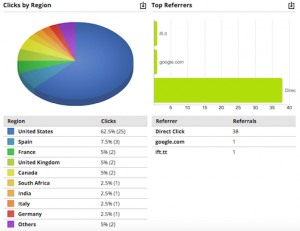— February 8, 2018
Want to boost your ecommerce sales? Well:
- You need to increase the number of new customers to your site.
- You need to increase the frequency in which they buy from you.
- You need to increase their average order value with each purchase.
That’s it. Easy, right?
Well not exactly — it will take hard work, a fair bit of patience and a lot of planning and content design to get the most out of your ecommerce strategy.
Thankfully with ecommerce, you can get a lot done if you just engage with your strategy on a daily basis. Rather than wrestling with content tasks for eight hours at a time, why not try attacking your strategy in 60 minute blocks instead? Here is how to switch up your strategy and become more productive.
Block 1 – Check in with your data
If you haven’t done so already, ensure that you are collating all of your social media and analytics data into one centralized dashboard.
It is vital to ensure that you have maximum visibility on who is visiting and exiting your site and what content is motivating them to check out your brand.
Once this is satisfied, it’s time to start crunching your numbers.
Checking your content analytics should be a daily habit because the content landscape is always changing – you need to be keeping an eye on how your strategy is evolving:
- Organize your dashboards so that you can quickly check top-level stats like last-click attributions and top referrals
- Review any specific campaigns you’re running — is it time to pull back, or put more budget behind them?
- Crunch your numbers and look at what’s working and what isn’t working. Then dig behind the good and bad points of your strategy to refine your approach and target it in a more effective way
Some of the great analytics tools that are available to help you make sense of your ecommerce data include:
Compass
Among other things, this gives you access to revenue, executive, insight, and benchmark reports, letting you see how you can further improve the economics of your business. Do just take my word for it, though. This is what’s been said by users of Compass:

Image credit: BigCommerce
This handy video has more information on what you can get out of Compass:
Semantics3 Analytics
You’ll love this, well, lovely piece of kit; it allows you to check the device that your customers are using to access your store, track your customers who are making repeat orders, and how many of your orders are coming from repeat orders. Who trusts in the quality of Semantics3 Analytics? These brands.

Image credit: Semantics3
If you want to learn more about this tool, and how you can apply it to your business, then head here to schedule a demo.
Plugging your dashboard into your existing online store is easy — a worthy investment that will greatly speed up the time you take to do your content marketing and increase its value.
Block 2 – Listen to your customers
Audience research is a crucial component of content marketing. You need to ensure that you are checking your audience metrics daily and following the online ‘chatter’ from consumers.
With all of your content marketing research, you are looking to answer your customer’s fundamental questions and present them with the benefits of your services. This is how you can shot to the apex of your bottom line of increasing the revenue of your ecommerce store.
Among the different ways that you can actively listen to your customers are:
- Social media — use analytics for your Facebook, Twitter, Instagram, and any other social media accounts that you have in your armory. Then look at what what’s gaining traction – if some of your content is getting more shares than the rest then it might be a time to invest in paid advertising to promote it to your customers.
- You will also want to invest some time into social listening (easy to do with monitoring tools) to get a feel for any pertinent trends or motifs you should be tackling in your content.
- Read some reviews and testimonials — this lets you establish what’s going right and wrong with your products. There may be a product which as a consistent issue. Digesting your customer reviews will allow you to spot and fix, turning a negative into a positive.
- If someone is selling similar products on Amazon, check out the Qs & reviews to be inspired about what to do next – why wouldn’t you want to learn from the master?
Spending just 10-15 minutes a day ‘checking in’ may be a better way to stay on top of your customers and audience, than investing in an expensive buyer persona audit. Little and often keeps the relationship fresh.
Block 3 – Go seasonal fast
Seasonal updates don’t have to take up weeks and weeks of planning — it’s easy to run a seasonal sale or update a website banner. These days, seasonal strategies can be launched in a matter of minutes.
However, seasonal updates and campaigns do require you to be organized and efficient – the important thing is not that you spend years planning, but that you know exactly what, when, and why you’re going to conduct each stage of the process.
One easy piece of your seasonal weaponry puzzle is to produce social media banners on Canva. Canva makes it as simple as possible to create blog graphics, posters, invitations, and social banners. You’ll be able to get up to speed with Canva in the time that it takes you to drink a mug of eggnog, and by the time you’ve devoured a slice of pumpkin pie you’ll have created a media banner!
Seasonal campaigning is also an excellent opportunity to introduce offers and discounts. These are useful for many reasons:
- You can inspire your customers to buy more of your products
- You can shift unwanted stock
- If you attach your offers and discounts to data-mining, you’ll have a mine of information to use in your long-term sales strategy.
When planning for seasonality, you should always put your best customers at the forefront. A loyal customer can create referrals ‘free of charge’ through word of mouth. Referral programs are easy to set up and automate – Yotpo offers a free service that “lets your customer do the talking,” or you could invest in the highly regarded ReferralCandy, which promises that you will “get more sales through word of mouth referrals.”
Whatever option you select for your customer referral software, the important thing to remember is that it offers your ecommerce business a valuable way of increasing your reach, appeal, and revenue in next to no time!
Block 4 – Network with influencers
Working with social and online influencers is a great way to take your store’s marketing to the next level. This is all about creating a community of brand advocates and supporters.
The key to great outreach is to check in little and often — you want to be constantly moving conversations forwards. Negotiations with big bloggers can take months of back and forth, so go out there and be heard as a brand by following up on conversations every day.
You should also reach out to people on social media. Engaging with your followers is a surefire way of drawing in new followers, and powerful social influencers are often much more receptive to a pitch on social media.
FameBit is a platform that is designed to connect companies with the right influencer for their brand, and spending a small portion of your time finding the right social influencer for your ecommerce brand could bring you in untold additional revenue.
Block 5 – Be a lean content machine
Don’t go out and write new content — mine your content operation to see what you’ve already got and make the most of it. This is a quick way to move the needle for your business without having to invest loads of time or money into it.
- Update a big post for this year — updated posts are often great for SEO
- Upcycle a low-value post — you can spin a post up with more content, videos, images etc.
- Recycle and reuse content that’s performed well — by being switched-on about your data, you should already have a pretty good idea of what posts and formats have been popular with your audience
- Re-jig a product description into a product guide or mash up a few blogs into a careguide
- Go out ‘on the floor’ and interview product managers, tech guys, CEOs, loyal customers — whoever will talk to you! These people often have so much insight to share, and in less than 30 minutes you may have just created a whole series of engaging posts
- Turn your FAQs into a mega blog or vice versa — questions and answers never grow old
- Curate some excellent, funny content — think about sharing content a la Buzzfeed to loosen up your brand voice and style.
The main lesson to take away — make the most of what you’ve already done and recycle, repurpose, and rejig content in order to save on time and budgets.
By spending a block of 60 minutes a day on any one of these 5 areas, you can create an ecommerce content strategy that will keep you ahead of the competition and latest consumer trends.
So what are you waiting for? Book yourself in an hour of your time a day for the next working week and by COB Friday your ecommerce company will be flying even higher.

Credit: Pixabay
Digital & Social Articles on Business 2 Community
(68)
Report Post



